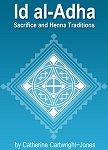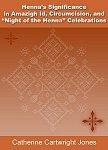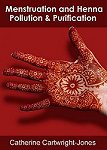|
Henna and Jnun
Across North Africa and the Middle East, people once believed that
humans lived alongside a parallel race of beings, the jnun (singular:
jinn, also djinn). The concept of jnun predated Islam, was
incorporated into the social practices of Islam, and was part of
people’s folk beliefs until the early twentieth century.
According to sacred text, God created these spirit beings from
smokeless fire two thousand years before God created man from
clay. Jnun could be malevolent bringers of disease and disaster, or
they could be benevolent bringers of luck and health. They obeyed God's
will, but could be contacted directly by people, and were open to
bribes and pleading. They could be male (jinn) or female
(jinniya). Malevolent jnun were attracted to blood, feces, semen,
stench, urine, and all foul things. Benevolent jnun were
attracted to beauty, fragrance, cleanliness, and henna. When jnun
were angry, they were vindictive, and would do favors when pleased. Catherine Cartwright-Jones c 2004 Kent State University Women’s health and fertility were imperiled by these jnun because the spirits were jealous of their babies, pregnancies, and milk. Jnun could enter a woman through her menstrual blood, so a menstruating woman was particularly apt to be infested with malevolent spirits. When jnun attacked a menstruating woman, they caused outbursts of temper, cramps, migraines, and depression. When a woman’s menstrual cycle was over, she went to the hammam, bathed, and applied henna to her hair, hands, feet, and vulva to banish lingering malevolent spirits. Women were most likely to be the intermediaries or mediums for jnun. This was a dangerous job, and a woman had to be specially bathed, dressed, perfumed and hennaed before she could safely interact on behalf of someone troubled with jnun. People generally did not respect or trust these mediums, but they sought their services and were a little afraid of them. Jnun could appear as people, seduce them, marry them, have children with them. The Queen of Sheba, Bilqis, was half jinn. This magical parentage allowed her to be as intelligent as a man, rule a country, and command an army. A jenniya might seduce a man and marry him. In Mazagan, Morocco in the late nineteenth century, a man brought home a second wife and his first wife refused to sleep with him. He was certain this was only because the new wife was jenniya . Another man in Tetouan was wealthy, well dressed, owned many guns, and his wife was generally kind. However, the morning after abused his wife, he awoke to find himself bound in bed, with his legs tied up . . . because she was jenniya. No human wife would tie up an abusive husband or refuse to sleep with him if he brought home a new wife. In 19th century Dukkala, a woman relentlessly tyrannized and attached her husband. He sought advice by praying to a saint’s spirit at the shrine Sidi Bbwarak, and the saint told him his wife was jenniya. The saint’s spirit helpfully shot the woman dead at midnight, and the man woke up the next morning relieved of all his miseries. Other men were able to rid themselves of jenniya wives by taking them on journeys, allowing to them to sleep outdoors alone. If a jackal attacked and ate the wife at night when nobody else was around, this was evidence that the wife was indeed jenniya, because jackals were fond of eating jnun . Cats, especially black ones, were often believed to be jnun, and people were unwilling to hit a cat for fear of serious consequences. Water tortoises were jnun, and people took care to not harm them. Cyclones moving across the North African deserts were jnun. 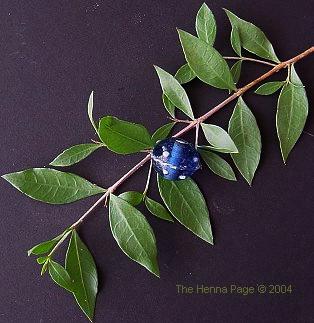 In the Middle East, wolves, rather than jackals, ate jnun. In nineteenth-century Iraq, women believed that wolves tried to catch and eat spirits in the forests. To escape the wolf, jnun transformed themselves into magical beads, and the bead contained the power of that spirit. Since Iraq is rich in archaeological sites, beads were left scattered in abandoned places. If a woman had one of these magical beads, she used henna to preserve its power. She would bathe, purify, henna herself on the twenthy-seventh day of Rajab. She would then perfume herself to attract benevolent spirits, pour rosewater over henna leaves, and place the bead on them. She chanted the “Ya Sin al Mughrabi ” prayer and an additional prayer, and then put the bead outside that night, in the dark of the moon. Women treasured their powerful, magical beads, passed them to their daughters, and loaned them to special friends. Mothers believed every child born had a parallel spirit. That spirit brought nightmares to children, and was the partner in adolescent erotic dreams. The jinn would cause the child to spill milk so that it could drink the milk instead of the child. When a child stumbled or fell, it had stepped on a jinn. In nineteenth-century Haifa, mothers believed that if their child had a serious fall, they should take their child to the sea on Friday. The mother washed the child’s hands and feet, and threw salt, barley, and henna into the waves so the jinn would stop bothering the child. 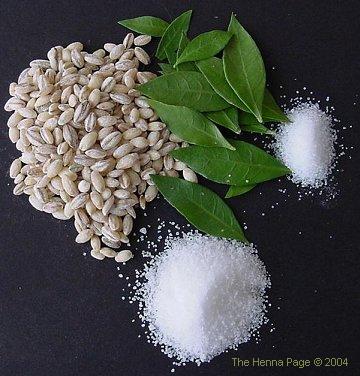 If a nineteenth-century Palestinian child was unaccountably frightened of something, jnun had surely frightened the child. The mother would go to the place of which the child was terrified (for instance, under the bed at night) and scatter salt, sugar, barley and henna there. She would say, “Take this and let us be reconciled: you shall neither harm us, nor shall we harm you. Take this barley for your donkeys, take this sugar for your children, take this henna and paint your children.” She left this there and didn’t sweep it away for many days in order to make certain the jnun had collected the food and hennaed their children. In nineteenth-century Lebanon, if a child awakened with red fingertips, their mother told them that a jinn hennaed them during the night. In nineteenth-century Ait Warain, Morocco, the household spirits were very fond of henna. If a guest brought henna into the house, that person was not to leave without putting a bit of henna into the fire or on the floor for the jnun to use. If the jnun didn’t get their henna, they would be so upset they might even kill one of the inhabitants or the domestic animals. If the guest had henna, and didn’t tell the host about it, the jnun would attack the guest rather than the members of the household. Few people in educated, urban twenty-first-century North Africa and the Middle East hold these folk beliefs now, though they often remember them as family traditions. If a 19th century Palestinian child was unaccountably frightened of something, jnun surely frightened the child. The mother would go to the place the child was terrified of (for instance, under the bed at night) and scatter salt, sugar, barley and henna there. She would say “Take this and let us be reconciled: you shall neither harm us, nor shall we harm you. Take this barley for your donkeys, take this sugar for your children, take this henna and paint your children”. She left this there, and didn’t sweep it away for many days, to make certain the jnun had collected the food, and hennaed their children. In 19th century Lebanon, if a child awakened with red fingertips, their mother told them that a jinn hennaed them during the night. In 19th century Ait Warain, Morocco, the household spirits were very fond of henna. If a guest brought henna into the house, that person was not to leave without putting a bit of henna into the fire or on the floor for the jnun to use. If the jnun didn’t get their henna, they would be so upset they might even kill one of the inhabitants or the domestic animals. If the guest had henna, and didn’t tell the host about it, the jnun would attack the guest rather than the members of the household. Few people in educated, urban, 21th century North Africa and the Middle East hold these folk beliefs now, though they often remember them as family traditions. In 2003, a Lebanese mother in Paris hennaed her daughters fingers as the girl slept and told her that she must be very special to have spirits henna her at night! People rarely claim with seriousness that henna is full of blessedness and can be used to thwart malevolent spirits or bribe benevolent ones, just as few westerners now really believe four leaf clovers and garlic are effective against ghosts, goblins, and “things that go bump in the night,” though newspaper astrology columns and phone psychics are as busy as ever! References: Edward Westermarck Ritual and Belief in Morocco: Vols 1 and 2 Macmillan London, 1926 Henry Field Folklore and Custons of Southwestern Asia Field Museum of Natural History Anthropological Series, Vol 33, Number 1, Chicago, 1940 See
books about henna traditions!
Web resources on Jinn According to Quran and Sunnah The Henna Page Main Index http://www.hennapage.com/henna/mainindex.html *"Henna,
the
Joyous Body Art"
the Encyclopedia of Henna Catherine Cartwright-Jones c 2000 registered with the US Library of Congress TXu 952-968 |
